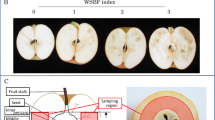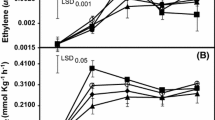Abstract
'Andesu' netted melon fruits (Cucumismelo. L.) were ventilated with pure nitrogen or air for 12 days from35 to 47 DAA or 6 days from 47 to 53 DAA (ripe and over-ripe stages,respectively). Exposure to anaerobic nitrogen atmosphere resulted in higheracetaldehyde and ethanol concentrations, while lower sucrose concentration wasrecorded in the mesocarp compared with air-ventilated fruit. However,water-soaked symptom was not developed under anaerobic nitrogen atmospheres,suggesting that the formation of water-soaking mesocarp tissue does not resultfrom increased alcoholic fermentation and/or decreased soluble sugaraccumulation in the flesh. Anaerobic nitrogen atmospheres also resulted in lowethylene production, high flesh firmness, and inhibition of depolymerisation ofpolyuronides and non-cellulosic neutral sugars in the cell walls. Theimportanceof increased intercellular spaces and membrane permeability on the developmentof water-soaked symptom was suggested.
Similar content being viewed by others
References
Agatsuma M. and Oshima E. 1981. Quality and chemical composition of fruits of melon 'Yubari king': Relations between deterioration and volatiles emanated. Res. Bull. Hokkaido Natl. Agric. Exp. Stn. 130: 145–152.
Beaulieu J.C., Peiser G. and Saltveit M.E. Jr. 1997. Acetaldehyde is a causal agent responsible for ethanol-induced ripening inhibition in tomato fruit. Plant Physiol. 113: 431–439.
Bernadac A., Jean-Baptiste I., Bertoni G. and Morard P. 1996. Changes in calcium contents during melon (Cucumis melo L.) fruit development. Sci. Hort. 66: 181–189.
Blakeney A.B., Harris P.J., Henry R.J.H. and Stone B.A. 1983. A simple and rapid preparation of alditol acetates for monosaccharide analysis. Carbohydrate Res. 11: 3291–3299.
Blumenkrantz N. and Asboe-Hansen G. 1973. New method for quantitative determination of uronic acid. Anal. Biochem. 54: 484–489.
Burdon J., Dori S., Marinansky R. and Pesis E. 1996. Acetaldehyde inhibition of ethylene biosynthesis in mango fruit. Postharvest Biol. Technol. 8: 153–161.
Dubois M., Gilles K.A., Hamilton J.K., Rebers P.A. and Smith F. 1956. Colorimetric method for determination of sugars and related substances. Anal. Chem. 28: 350–356.
du Chatenet C., Latché A., Olmos E., Ranty B., Charpenteau M., Ranjeva R. et al. 2000. Spatial-resolved analysis of histological and biochemical alterations induced by water-soaking in melon fruit. Physiol. Plant. 110: 248–255.
Dunlap J.R., Slovin J.P. and Cohen J.D. 1996. Indole-3-acetic acid, ethylene, and abscisic acid metabolism in developing muskmelon (Cucumis melo L.) fruit. Plant Growth Regul. 19: 45–54.
Ferguson I.B. 1984. Calcium in plant senescence and fruit ripening. Plant Cell Environ. 7: 477–489.
Gross K.C. and Sam C.E. 1984. Changes in cell wall neutral sugar composition during fruit ripening: A species survey. Phytochemisitry 23: 2457–2461.
Horvat R.J. and Senter S.D. 1987. Identification of additional volatile compounds from Cantaloupe. J. Food Sci. 52: 1097–1098.
Jean-Baptiste I., Morard P. and Bernadac A. 1999. Effects of temporary calcium deficiency on the incidence of a nutritional disorder in melon. Acta Hortic. 481: 417–423.
Kitamura T. 1974. Studies on the storage of melon fruits. I. Changes in respiration, ethylene production and volatiles production during ripening with reference to cultivars. Bull. Yamagata. Univ. Agr. Sci. 7: 253–260.
Kubo K. 1986. Studies on the abnormal fermentation of melon fruit (Cucumis melo cv. 'Prince'). Bull. Kumamoto Agr. Exp. Stn. 11: 1–42.
Lurie S. and Ben-Arie R. 1983. Microsomal membrane changes during the ripening of apple fruit. Plant Physiol. 73: 636–638.
Lurie S., Sonego L. and Ben-Arie R. 1987. Permeability, microviscosity and chemical changes in the plasma membrane during storage of apple fruit. Scientia Hort. 32: 73–78.
Lurie S., Othman S. and Borochov A. 1995. Effects of heat treatment on plasma membrane of apple fruit. Postharvest Biol. Technol. 5: 29–38.
McCollum T.G., Huber D.J. and Cantliffe D.J. 1989. Modification of polyuronides and hemicelluloses during muskmelon fruit softening. Physiol. Plant. 76: 303–308.
Miccolis V. and Saltveit M.E. Jr. 1991. Morphological and physiological changes during fruit growth and maturation of seven melon cultivars. J. Amer. Soc. Hort. Sci. 116: 1025–1029.
Motomura Y. 1994. Formation of alcoholic substances in muskmelon: variation among cultivars and with maturity. Scientia Hort. 58: 343–350.
Nakanishi M., Kurata K. and Kitagawa M. 1992. Effects of shading and irrigation on the occurrence of physiological disorder “urumika” in melon fruit. Sand Dune Res. 39: 9–17.
Nishizawa T. and Shishido Y. 1998. Changes in sugar and starch concentrations of forced June-bearing strawberry plants as influenced by fruiting. J. Amer. Soc. Hort. Sci. 123: 52–55.
Nishizawa T., Taira S., Nakanishi M., Ito M., Togashi M. and Motomura Y. 1998. Acetaldehyde, ethanol, and carbohydrate concentrations in developing muskmelon fruit (Cucumis melo L. cv. Andesu) are affected by short-term shading. HortScience 33: 992–994.
Nishizawa T., Ito A., Motomura Y., Ito M. and Togashi M. 2000. Changes in fruit quality as influenced by shading of netted melon plants (Cucumis melo L. 'Andesu' and 'Luster'). J. Japan. Soc. Hort. Sci. 69: 563–569.
Nyanjage M.O., Wainwright H. and Bishop C.F.H. 1999. Effects of hot-water treatment and storage temperature on electrolyte leakage of mangoes (Mangifera indica Linn.). J. Hort. Sci. Biotech. 74: 566–572.
Pesis E., Levi A. and Ben-Arie R. 1988. Role of acetaldehyde production in the removal of astringency from persimmon fruits under various modified atmospheres. J. Food Sci. 53: 153–156.
Pesis E. and Marinansky R. 1992. Carbon-dioxide and ethylene production by harvested grape berries in response to acetaldehyde and ethanol. J. Amer. Soc. Hort. Sci. 117: 110–113.
Podd L.A. and van Staden J. 1998. The role of ethanol and acetaldehyde in flower senescence and fruit ripening — A review. Plant Growth Regul. 26: 183–189.
Pratt H.K., Goeschl J.D. and Martin F.W. 1977. Fruit growth and development, ripening, and the role of ethylene in the 'Honey Dew' muskmelon. J. Amer. Soc. Hort. Sci. 102: 203–210.
Rose J.K.C., Hadfield K.A., Labavitch J.M. and Bennett A.B. 1998. Temporal sequence of cell wall disassembly in rapidly ripening melon fruit. Plant physiol. 117: 345–361.
Saltveit M.E. Jr. and Ballinger W.E. 1983a. Effects of anaerobic nitrogen and carbon dioxide atmospheres on ethanol production and postharvest quality of blueberries. J. Amer. Soc. Hort. Sci. 108: 459–462.
Saltveit M.E. Jr. and Ballinger W.E. 1983b. Effects of anaerobic nitrogen and carbon dioxide atmospheres on ethanol production and postharvest quality of 'Carlos' grapes. J. Amer. Soc. Hort. Sci. 108: 462–465.
Seymour G.B. and McGlasson W.B. 1993. Melon. In: Seymour G.B., Taylor J. and Tucker G. (eds), Biochemistry of Fruit Ripening. Chapman &; Hall, London.
Simandjuntak V., Barrett D.M. and Wrolstad R.E. 1996. Cultivar and frozen storage effects on muskmelon (Cucumis melo) color, texture and cell wall polysaccharide composition. J. Sci. Food Agric. 71: 291–296.
Smagula J.M. and Bramlage W.J. 1977. Determination of acetaldehyde in apple tissue by 2,4-dinitrophenylhydrazone formation. J. Food Sci. 42: 48–51.
Toivonen P.M.A. 1997. Non-ethylene, non-respiratory volatiles in harvested fruits and vegetables: their occurrence, biological activity and control. Postharvest Biol. Technol. 12: 109–125.
Yamada H., Minami J., Amano S. and Kadoya K. 2001. Development of early watercore in 'Orin' apples grown in warmer regions. J. Japan. Soc. Hort. Sci. 70: 409–415.
Author information
Authors and Affiliations
Rights and permissions
About this article
Cite this article
Nishizawa, T., Tamura, A., Mitsuzuka, S. et al. Water-soaked symptom of 'Andesu' netted melon fruit does not develop under anaerobic nitrogen atmospheres during ripening. Plant Growth Regulation 38, 7–14 (2002). https://doi.org/10.1023/A:1020956512115
Issue Date:
DOI: https://doi.org/10.1023/A:1020956512115




